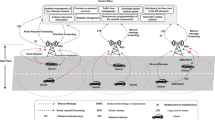Abstract
One of the main problems in the VANET (vehicular ad-hoc network) routing algorithms is how to establish the stable routes. The link duration in these networks is often very short because of the frequent changes in the network topology. Short link duration reduce the network efficiency. Different speeds of the vehicles and choosing different directions by the vehicles in the junctions are the two reasons that lead to link breakage and a reduction in link duration. Several routing protocols have been proposed for VANET in order to improve the link duration, while none of them avoids the link breakages caused by the second reason. In this paper, a new method for routing algorithms is proposed based on the vehicles trips history. Here, each vehicle has a profile containing its movement patterns extracted from its trips history. The next direction which each vehicle may choose at the next junction is predicted using this profile and is sent to other vehicles. Afterward each vehicle selects a node the future direction of which is the same as its predicted direction. Our case study indicates that applying our proposed method to ROMSGP (receive on most stable group-path) routing protocol reduces the links breakages and increases the link duration time.
Similar content being viewed by others
References
Andreone L, Ricerche C. Activities and applications of the vehicle to vehicle and vehicle to infrastructure communication to enhance road safety. In: Proceedings of the 5th European Congress and Exhibition, Hannover, 2005
Morris R, Jannotti J, Kaashoek F, et al. Carnet: a scalable ad hoc wireless network system. In: Proceedings of the 9th ACM SIGOPS European Workshop. New York: ACM, 2000. 61–65
Pedersen M V, Heide J, Fitzek F H P, et al. A mobile application prototype using network coding. Eur Trans Telecommun, 2010, 21: 738–749
Ott J, Kutscher D. A modular access gateway for managing intermittent connectivity in vehicular communications. Eur Trans Telecommun, 2006, 17: 159–174
Taleb T, Sakhaee E, Jamalipour A, et al. A stable routing protocol to support ITS services in VANET networks. IEEE Trans Veh Technol, 2007, 56: 3337–3347
Menouar M, Lenardi M, Filali F. A movement prediction based routing protocol for vehicle-to-vehicle communications. In: Proceedings of 1st International Vehicle-to-Vehicle Communications Workshop, San Diego, 2005
Granelli F, Boato G, Kliazovich D. MORA: a movement-based routing algorithm for vehicle ad hoc networks. In: Proceedings of IEEE Workshop on Automotive Networking and Applications, San Francisco, 2006. 1–10
Granelli F, Boato G, Kliazovich D, et al. Enhanced GPSR routing in multi-hop vehicular communications through movement awareness. IEEE Commu Lett, 2007, 11: 781–783
Karp B, Kung H T. GPSR: greedy perimeter stateless routing for wireless networks. In: Proceedings of the 6th Annual International Conference on Mobile Computing and Networking. New York: ACM, 2000. 243–254
Namboodiri V, Gao L. Prediction-based routing for vehicular ad hoc networks. IEEE Trans Veh Technol 2007, 56: 2332–2345
Kim J H, Lee S K. Reliable routing protocol for vehicular ad hoc networks. Int J Electron Commun, 2011, 65: 268–271
Simié M I, Pejović P V. A comparison of three methods to determine mobile station location in cellular communication systems. Eur Trans Telecommun, 2009, 20: 711–721
Qin D Y, Sha X J, Xu Y B. A fast local routing repair scheme for wireless mobile ad hoc network. Sci China Inf Sci, 2011, 54: 111–122
Froehlich J, Krumm J. Route prediction from trip observations. SAE SP, 2008, 2193: 53
Bohlooli A, Jamshidi K. A GPS-free method for vehicle future movement directions prediction using SOM for VANET. App Intell, 2012, 36: 685–697
Hasan A. VANET Simulation. Dissertation for Master Degree. Halmstad: Halmstad University, 2009
Guo H, Ge J H. Diversity order of multiuser two-way relay networks with beamforming over Nakagami-m fading channels. Sci China Inf Sci, 2011, 54: 1986–1990
Author information
Authors and Affiliations
Corresponding author
Rights and permissions
About this article
Cite this article
Bohlooli, A., Jamshidi, K. Profile based routing in vehicular ad-hoc networks. Sci. China Inf. Sci. 57, 1–11 (2014). https://doi.org/10.1007/s11432-013-4952-0
Received:
Accepted:
Published:
Issue Date:
DOI: https://doi.org/10.1007/s11432-013-4952-0




